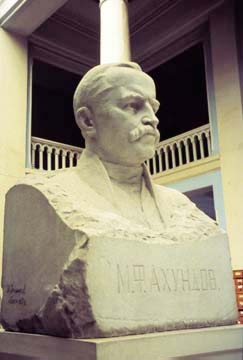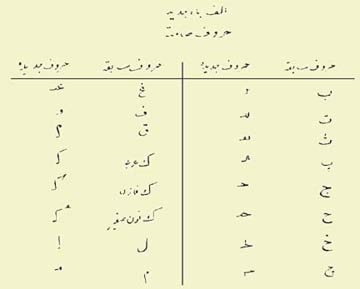|

Spring
2000 (8.1)
Mirza Fatali
Akhundov
Alphabet
Reformer Before His Time
by
Farid Alakbarov
  The Manuscript Institute
has a special section in its archives dedicated to the work of
Mirza Fatali Akhundov (1812-1878), including both published and
unpublished manuscripts. Though Akhundov is mostly remembered
for his founding work in theater and drama, his contribution
to alphabet reform was enormous. The Manuscript Institute
has a special section in its archives dedicated to the work of
Mirza Fatali Akhundov (1812-1878), including both published and
unpublished manuscripts. Though Akhundov is mostly remembered
for his founding work in theater and drama, his contribution
to alphabet reform was enormous.
Akhundov worked as an interpreter in Tiflis (Tbilisi, Georgia)
and began his work regarding alphabet reform in 1850. His first
efforts focused on modifying the Arabic script so that it would
more adequately satisfy the phonetic requirements of the Azeri
language. First, he insisted that each sound be represented by
a separate symbol - no duplications or omissions. The Arabic
script expresses only three vowel sounds, whereas Azeri needs
to identify nine vowels.
Photo: Bust of Mirza Fatali
Akhundov, inside the library that bears his name in Baku.
Second, he hoped to rid the script of diacritical marks such
as "dots and loops," which he felt slowed down the
handwriting process. Third, he felt that literacy would be facilitated
if the script were written in a continuous fashion with no breaks
in words. This would enable people to more readily discern where
words began and ended.
In 1863, Akhundov went to Istanbul and personally presented his
ideas to the Scientific Society of Osmanlis. His proposals triggered
serious debates in the Turkish newspapers. A number of publishers
and intellectuals were against this reform. However, poet Namik
Kamal strongly defended his efforts.
  Hot debates ensued and
were amplified by those who sought to purify Turkic languages
and purge all Arabic and Persian words from the Turkic vocabulary.
In the end, conservative forces won out, not only in Azerbaijan,
but in Turkey as well. The greatest resistance came from those
who believed that since the Koran was written in the Arabic script,
it is holy and should not be tampered with. Akhundov finally
realized that it would be impossible to carry out even negligible
reforms in regard to the Arabic alphabet. Archival materials
at the Institute show that Iran strongly opposed this project,
according to views set forth by the Iranian Ambassador to Turkey. Hot debates ensued and
were amplified by those who sought to purify Turkic languages
and purge all Arabic and Persian words from the Turkic vocabulary.
In the end, conservative forces won out, not only in Azerbaijan,
but in Turkey as well. The greatest resistance came from those
who believed that since the Koran was written in the Arabic script,
it is holy and should not be tampered with. Akhundov finally
realized that it would be impossible to carry out even negligible
reforms in regard to the Arabic alphabet. Archival materials
at the Institute show that Iran strongly opposed this project,
according to views set forth by the Iranian Ambassador to Turkey.
Photo: Columns in order: the
second version of Azerbaijan's Latin alphabet (after 1928), the
pre-reform Azeri Arabic script and Akhundov's proposed Latin
script.
By 1878, Akhundov had given up on trying to reform the Arabic
script and was refocusing his attention on introducing a Latin-modified
alphabet with a few Cyrillic characters. "Whoever wants
to use the traditional Arabic script may use it, others can opt
for the new alphabet," Akhundov would say. Nevertheless,
despite the fact that he included a few Cyrillic characters in
the proposed script, the Russian government did not lend any
support to his efforts. And again, this project failed.
Nevertheless, he managed to bring these issues into the public
arena, and some intellectuals began discussing it in the media.
In 1886, seven years after Akhundov's death, the newspaper "Caucasus"
published an article by Mirza Alimammad calling for a change
of the Arabic script. In 1898, several issues of the same paper
published a lengthy article by Firudin bey Kocharli entitled,
"The Arabic Alphabet and its Shortcomings."
Jalil Mammadguluzade, editor of the famous publication "Molla
Nasraddin" (1906-1931), commented on the Arabic script and
the need for reform: "It is necessary to substitute these
hieroglyphs with the Latin script."
Nariman Narimanov, an active member of the government in the
early part of the century, also criticized the Arabic script.
Narimanov's solution was to accept Cyrillic, as he had written
some of his novels in a modified script he had created to express
the peculiarities of Azeri phonology.
Akhundov was clearly a visionary whose ideas would follow only
half a century later.
Azerbaijan officially adopted a Latin-modified alphabet on October
20, 1923. At the beginning, both Arabic and Latin were allowed
to jockey for popular use. But by January 1st, 1929, the atheist
government of the Soviet Union banned the use of the Arabic alphabet
in Azerbaijan. Enormous book-burning campaigns were carried out
to obliterate the memory of this script.
  Photo: The 1857 version of
Akhundov's proposed reformed Arabic-based script. Photo: The 1857 version of
Akhundov's proposed reformed Arabic-based script.
Charts courtesy of "Schriftreform und Schriftwechsel bei
den Muslimischen Russland- und Sowjetturken" by Ingeborg
Baldauf (Akademiai Kiado, 1993).
Five years after Azerbaijan introduced the Latin script, Turkey
reached the same decision in November 1928. The law went into
effect on January 1, 1929.
But Turkey's decision to opt for an alphabet that was readable
by Soviet Turkic nations was troublesome for Stalin, who feared
that they would unite together against his authority. He hadn't
expected Turkey to adopt Latin as well. Therefore, ten years
later in 1939, Stalin moved swiftly to undermine such efforts
and quickly imposed widespread use of Cyrillic in all Islamic
regions of the Soviet Union.
Akhundov would no doubt have smiled had he known that one of
the first significant legislative acts of the Parliament of the
newly independent Azerbaijan Republic was the re-adoption of
the Latin alphabet. The decision came only a few short weeks
after independence, on December 25, 1991. Akhundov's legacy lives
on.
From Azerbaijan International (8.1) Spring 2000.
© Azerbaijan International 2000. All rights reserved.
Home
| About Azeri | Learn
Azeri | Contact us
|